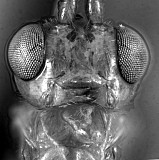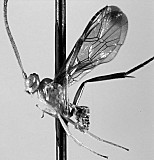Physotarsus eliethi Gauld, 1997
Physotarsus eliethi: Yu and Horstmann 1997: 455 (catalog); Zhaurova and Wharton 2009: 9-10, 21-23 (redescription, inclusion in key to species).
Physotarsus eliethi is readily distinguished from other smooth-bordied species with pale mesosomas by the exceptionally long, narrow first flagellomere (about 10X longer than wide).
There are no specimens currently determined for this OTU, or those specimens determined for this OTU are not yet mappable.
This material is based upon work supported by the National Science Foundation under Grant Number DEB 0328922 with REU supplement DEB 0723663.
Any opinions, findings, and conclusions or recommendations expressed in this material are those of the author(s) and do not necessarily reflect the views of the National Science Foundation.



